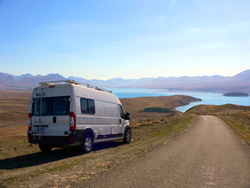





New Zealand: A Caravan Experience
Written By: SUSANNE LOMATCH
PAGE 2....
Caravan Hire & Pickup
Day 4
After checking out of the hotel, we took a long cab ride to the outskirts of sprawling Auckland
to pick up our reserved caravan. We made reservations over the web for our caravan almost five
months in advance, though this is not necessary, especially if traveling anytime outside of the
high late spring/summer season. Advance reservations usually require a deposit denominated in
NZ dollars; therefore, exchange rates are an important factor. Though we got a guaranteed rate,
we paid the deposit at a time when the dollar was relatively low against the NZ dollar.
This reversed five months later when we landed in NZ, so the balance of the rental fee was less
than we budgeted. A word of caution: when searching for a caravan hire company, be careful to
look for reviews
(we unfortunately didn’t). We chose a company for its well-designed website targeted to American
travelers, but this company turned out to be quite poorly run, and we ended up with a vehicle
that was older and not serviced regularly – in short, it was past its life as a rental vehicle.
The company manager gave us a discount at pickup, but we would rather have had a newer vehicle.
There are many companies to choose from. When searching, use the term ‘caravan’ to get NZ companies
(Britz is one of the larger and more reputable); the term ‘motorhome’ will get you companies that
advertise primarily to Americans.
 Caravans for hire can be anything from a modified panel van with a place for two to
sleep, to motorhomes that sleep up to six and have a fully appointed kitchen and bath.
Caravans in NZ are euro-spacious: translated, they are compact where possible, unlike
their decadent American cousins, the full-size motorhomes and custom luxury coaches. A
recommendation for couples is a 2-3 berth vehicle with a kitchen and shower bath – this
is the vehicle we rented. Unless you request it, rental vehicles will have a manual
transmission, meaning the driver’s side and stick are located opposite those in countries
where driving is on the right – Kiwis drive on the left!
Caravans for hire can be anything from a modified panel van with a place for two to
sleep, to motorhomes that sleep up to six and have a fully appointed kitchen and bath.
Caravans in NZ are euro-spacious: translated, they are compact where possible, unlike
their decadent American cousins, the full-size motorhomes and custom luxury coaches. A
recommendation for couples is a 2-3 berth vehicle with a kitchen and shower bath – this
is the vehicle we rented. Unless you request it, rental vehicles will have a manual
transmission, meaning the driver’s side and stick are located opposite those in countries
where driving is on the right – Kiwis drive on the left!
Most caravans with kitchens come with a refrigerator that runs off of the battery, which
can be recharged several ways: via the engine, via propane, and/or via a roof-installed
solar unit. This convenience cannot be understated: a fully food-stocked caravan is a
must, with stock kept cool or frozen as needed. Even in small 2-3 berth vehicles, kitchens
have ample cabinet and counter space, a gas cooking range with broiler, and sufficient
cooking/dishware. The smaller the vehicle, the greater the sacrifices. The dining area is
usually converted in the evening to a sleeping area for two, with extra cushions available
that fit on top of a lowered dining table. (Talk about making love on the dining table!) In
a 2-3 berth, the 3rd berth is usually located above the driving cab. We made sure to get
this type of vehicle knowing we would need the extra space for luggage storage and, as it
turned out, storage for 2-3 cases of wine we picked up along the way. In the smaller
vehicles, bathrooms are svelte closets with a commode, which double as a shower stall,
and contain a flip-down washbasin. We never used the shower or washbasin, opting
instead to take longer hot showers that are widely available at caravan parks. Most
caravan parks in NZ have full water and electric hookups in plentiful numbers, so usage
of the caravan shower is completely possible, and even one with decent hot water. But
since we were usually already paying for spacious hot showers we opted for those, as
shower usage in the caravan fills up the gray water tanks quite quickly. Water and waste
maintenance is a chore – tanks must be emptied every couple days in smaller vehicles.
We opted to dump our gray and leftover clean water tanks every time we left a park and
hit the road – sometimes daily – the NZ terrain is mountainous and hilly and vehicle
weight matters in terms of power and diesel mileage. Black water waste (commode) is
usually collected in a smaller cassette-type container that must be monitored for cleaning.
Be sure to pick up gloves and additional waste treatment fluid if the rental company
doesn’t already provide those. Don’t let all of this arduous detail deter you and your
fellow travelers – there is nothing like being in the middle of nowhere among spectacular
scenery and having the convenience of a caravan commode when nature calls!
When picking up your caravan, make sure the rental agency has someone to talk you
through the use of the vehicle. Ultimately, this is a protective measure for the customer,
as you will likely be asked to sign a lengthy rental agreement that requires proper
recreational vehicle maintenance while on the road, such as keeping the waste water
tanks clean, or avoiding a service call from a dead battery. Unlike in the U.S., the
majority of caravan parks in NZ have a common kitchen with a dining area, and some
form of entertainment (computers with Internet, WAN/Wi-Fi, television), meeting the
needs of those who really don’t want to deal with these maintenance issues and just want
a place to sleep. Any rental outlet will have endless guidebooks and maps for you to take,
including comprehensive listings of caravan parks. That said, it helps to have a GPS. We
brought our portable auto Garmin GPS with us, loaded with the latest NZ maps and
waypoints. When we couldn’t find a caravan park in the paper guides, we usually found
one in the GPS – a convenience when rolling into the next little town at a late hour! Most
caravan rentals come with a GPS option, but it can be quite expensive – at least $10NZD
per day. If you’re there on a long stay it pays to bring your own.
Some special notes about Internet/Wi-Fi availability and cell phone access across NZ.
In Auckland, Wi-Fi hotel charges were out of our price range (and quite scalping) – the hotel
charged a high flat fee by the day but then if you go over a data limit of say 100MB (which is
very easy to do when doing anything but quickly checking mail), they started charging an extra
rate by the MB (or by the minute, I forget which). We found out that this was common at most NZ
hotels. Luckily, we discovered a coffee chain – Esquires –
that had decent Wi-Fi access for an hour, with purchase. Most caravan parks we stayed at had WAN/Wi-Fi –
but only a minority provided it for free. Many times it was available through a national service
company that supplies WAN/Wi-Fi infrastructure to caravan parks and/or coffee houses, the largest
being 2Hotspot Wireless (a company from Texas!). We signed up for access through this service at a
handful of parks, and it averaged $3 per access (day), charged to our credit card. American cell
phones running under the CDMA standard do not work in NZ – GSM is the dominant standard. We looked
into getting a prepaid phone, but this was uncommon/unavailable at the time of our travels. All
the cell phone stores we visited wanted us to sign at least a 1-year contract. The best option is
to either buy a pre-paid calling card (which we ended up doing) or rent a compatible cell phone
before commencing your trip (which we found out about afterwards – see
cellularabroad.com,
for example). Since pre-paid phones are quite common and relatively cheap in the U.S., we didn’t
think about the difficulty ahead of time. Before your trip, check to see whether pre-paid phones
are becoming adopted in NZ!
It took us some time to adjust to driving a stick on the left again, and a diesel truck body at that.
On the way out of Auckland we stopped at a supermarket and stocked up on food and supplies, including a
cheap but precious French coffee press for the serious coffee-holic in our midst. Given the late
afternoon we took the advice of the caravan hire company to spend the night at a caravan park at
Waiwera, which is north of Auckland on the coast, and a popular area for its geothermal hot springs,
including pools specifically designed so that the whole family can soak in the mineral baths. Though
this is a beautiful coastal area reminiscent of California, we recommend skipping it if you are anxious
to head southeast to spectacular scenery and the start of the NZ wine trail. The peninsula north of
Auckland is must for those looking for summer water sports, such as scuba diving, fishing and sailing,
but it just wasn’t summer yet. On that note, we stopped at one of the many coastal cliff areas to walk
down along the tide pools, and caught these captive shots.